Introduction
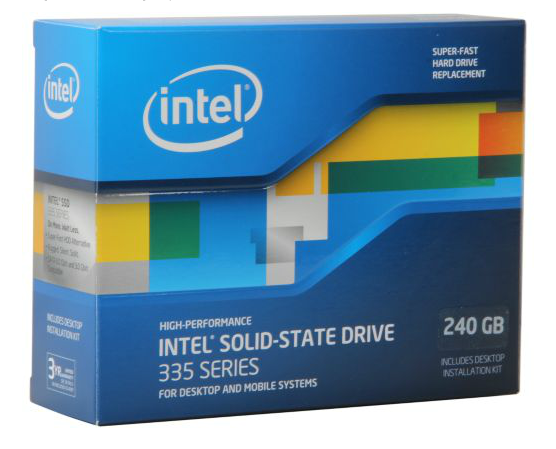
Looking back, Intel's 520 Series was the best SSD build using the LSI SandForce SF-2281 controller. Intel was allowed to build its own firmware for the 2281 and as a result didn't need to do the firmware dance. When SandForce need to make big changes to the programming in order to work with 19nm Toggle flash, Intel didn't need to follow the same path because they own a flash fab - well, 49% of it anyway.
Intel, like other SSD manufacturers, chose a two tier approach for the consumer SSD market. The 520 Series holds the top spot, even today, with 25nm ONFi synchronous 5K P/E flash. The value or mainstream SSD product was the 330 Series. The 330 Series also used 25nm ONFi synchronous flash, but with 3K P/E cycles. The 330 is out and the new 335 takes over as the mainstream SSD offering for Intel.
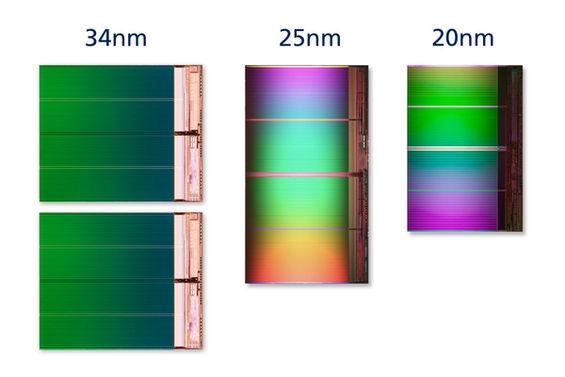
Intel's 335 Series has nearly identical specs to the 330 Series, but ships (as of now) only in 240GB capacity size and uses 20nm synchronous NAND flash. Intel rates the new 20nm flash at 3K P/E cycle just like the 25nm flash used on the 330.
Even though the 330 and 335 share almost identical spec sheets, we expect some improvement in other areas. Intel had an extra year to work on the 335 Series firmware. Firmware and programming are just as important as the hardware used to make an SSD. We also want to keep an eye on latency since latency should increase as the lithography shrinks. The LSI SandForce SF-2281 is the perfect controller to look for increased latency since it lacks a DRAM buffer.
Specifications, Pricing and Availability

First let's look at the 335 Series specs on its own and then compare the new drive to the 330 and 520 Series.
Intel was very conservative on the spec list. An example of their conservatism was the rated sequential read performance. Intel claims 500MB/s, but in our testing with ATTO, the standard for rating sequential performance was nearly 558MB/s. The same was true in nearly every category on the spec sheet.

Here we see the breakdown of three Intel consumer SSDs - 330, 335 and 520. 20nm flash does significantly change one area for the better, and that's power consumption. The 335 with 20nm flash has an idle power consumption of just 275mW.
For most notebook users, the idle power consumption is the most important category to have a very lower value in since your SSD is idle more than it's moving data. Both the idle and active power is reduced by more than half. We're testing Intel's power today in our new power tests later in this review.
At the time of writing Newegg had all three of the drives we're comparing on this page in stock. Both the 330 and 335 240GB were available for $199.99. The Intel 520 240GB was $249.99, all SSD pricing taken from full retail box versions. All three drives ship with the same accessory kits, but the 330 and 335 have three year warranties and the 520 has a five year warranty.
Packaging
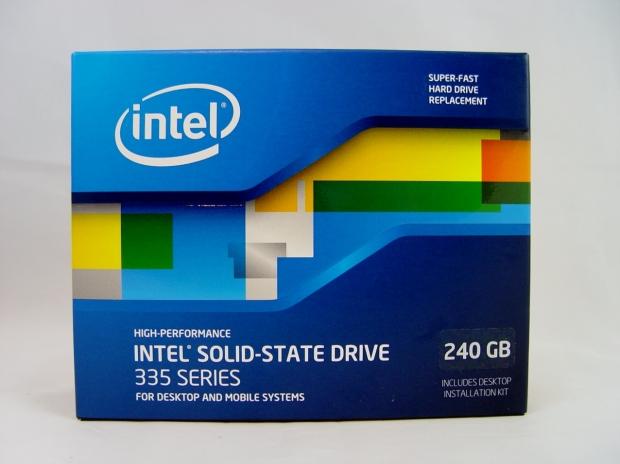
Intel is one of the few SSD manufacturers with drives in retail locations. With that in mind let's look at the 335 Series package like a customer in a brick and mortar store.
The 335 Series box is a lot like many of Intel's other products. In my office, I sometimes mistake CPU boxes for SSD boxes.
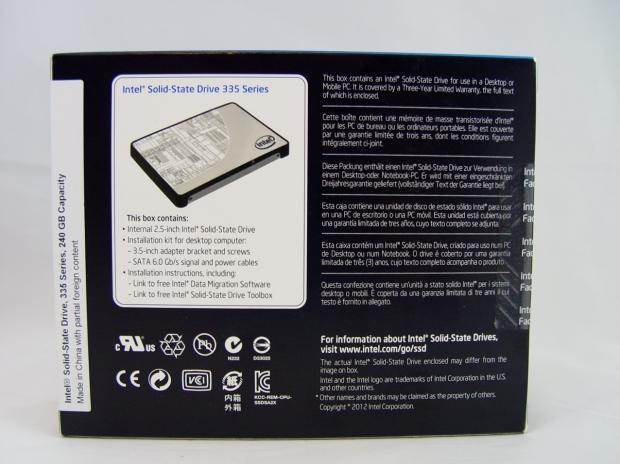
Intel delivers a fair amount of information on its SSD package. You'll need to look at all six sides to take it all in, but the data is there for those willing to look for it.

The inner packaging keeps the drive safe and away from the other components. The desktop adapter bracket, paper guides, screws and other accessories are tucked away behind the cardboard drive holder.

Inside side we found a very nice accessory package that included a SATA data and power cable. I get a lot of emails from people who buy HDDs and SSDs and forget to order a SATA cable. They are forced to run to a B&M store to spend $15 on a SATA cable. Very few HDDs/SSDs ship with SATA cables and we really like seeing Intel include them.

Intel also includes a fairly unique desktop adapter bracket. 2.5" to 3.5" adapters are common, but Intel's has a really nice feature. It includes bottom mounts for drive sleds. Below the Intel adapter bracket is a drive sled from an Antec Take-4.
The drive is still set in the middle though so you can't use the drive sled with a backplane, but at least you can get the drive in your legacy drive sled.
Intel 335 Series 240GB SSD
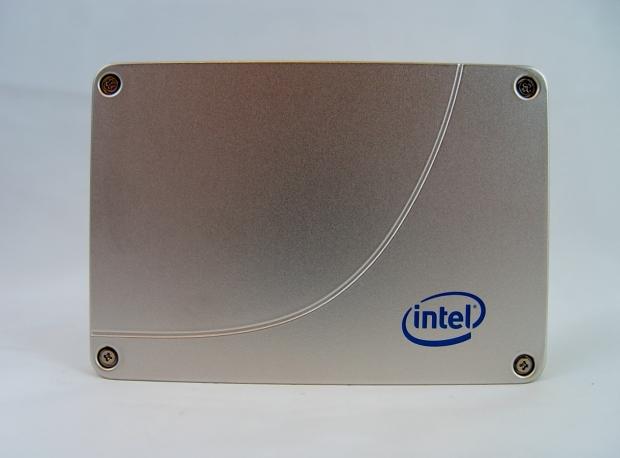
Here we get our first look at the Intel 335 Series. The familiar Intel curve is still on the front of the drive, but the label was moved to the back of the SSD.
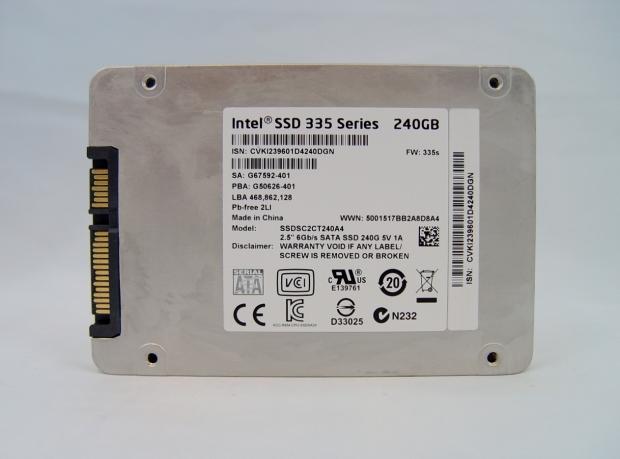
The serial number, product number and capacity size are on the back label.

I really didn't expect Intel to ever release another 9.5mm z-height drive after marketing ultrabooks so heavily, but here we are with another 9.5mm drive that won't fit in your shiny new ultrabook computer.
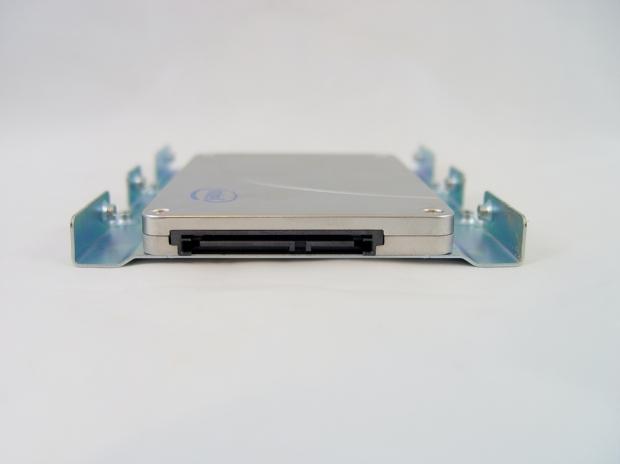
All of the mounting points are where they should be and the SATA connectors are as well. The adapter bracket centers drive so the power and data connectors aren't in line with your 3.5" HDDs.

If you ever wanted to know what the inside looks like here is a quick shot. Intel uses a thermal pad on the LSI SandForce SF-2281 controller. A spacer inside fills a gap so Intel can use the same bottom half for 9.5mm and 7mm z-height SSDs.

The inside of the 335 looks about the same as the 330 Series other than the 20nm NAND flash.

There are sixteen chips, eight on each side and all the same density.

Intel's marketing page talks about reduced power consumption, but they chose not to roll SandForce's new lower power controller into the 335 Series. To be fair, no one that we know of has used B02 2281 into a retail product, but SandForce announced the new silicon months ago. We'll have a B02 prototype in hand later this week, but we're still working out the details on publishing performance numbers.

20nm flash makes its first appearance in a high profile retail SSD. The 335 Series uses NAND receiving a clock signal, often referred to as synchronous flash. A few months ago, we started measuring power usage and the lowest power SSDs have usually shipped with Toshiba Toggle Mode flash. 20nm is Intel's best shot at reducing power consumption with the aging LSI SandForce 2281 SSD controller.
Benchmarks - Test System Setup and ATTO Baseline Performance
Desktop Test System

Lenovo W530 - Mobile Workstation
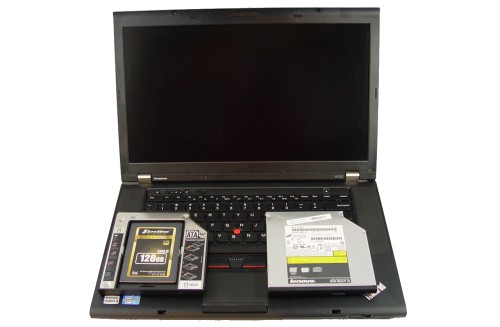
We use two systems for SSD testing. The desktop runs a majority of the tests and the Lenovo W530 runs the notebook power tests as well as the real-world file transfer benchmark.
ATTO Baseline Performance
Version and / or Patch Used: 2.34
ATTO is used by many disk manufacturers to determine the read and write speeds that will be presented to customers.

In ATTO we measure maximum performance with a file system on the drive at a queue depth of 4. Our read performance maxed at nearly 558MB/s and the write speed was nearly 534MB/s. Although the 335 Series has a lower spec than Intel's 520 Series, the write speed was higher on the 335 than it was the 520 when we measured it several months ago.
The Intel 520 scored 556.6MB/s read and 526.3MB/s write in our retest on the same motherboard just a couple of weeks ago.
Benchmarks - Sequential Performance
HD Tune Pro
Version and / or Patch Used: 4.00
Developer Homepage: http://www.efdsoftware.com
Product Homepage: http://www.hdtune.com
HD Tune is a Hard Disk utility which has the following functions:
Benchmark: measures the performance
Info: shows detailed information
Health: checks the health status by using SMART
Error Scan: scans the surface for errors
Temperature display
HD Tune Pro gives us accurate read, write and access time results and for the last couple of years has gained popularity amongst reviewers. It is now considered a must have application for storage device testing.
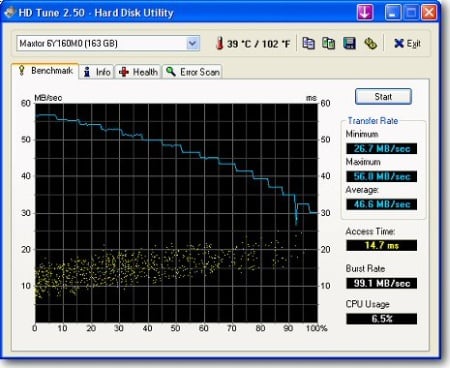

Intel's stated performance would lead you to believe the 335 will take a back seat to the 520 in performance, but our numbers show the two drives running very close to each other in many tests. Here we see the sequential read performance and both drives have an average speed of 421MB/s when working with compressible data.

Sequential write performance is also very close, but the 335 takes a 12MB/s lead. It should be stated that SSDs slow over time and our 520 Series sample has ran through four full benchmark cycles, but that shouldn't be enough to reduce the performance.
Benchmarks - AIDA64 Random Access Time
AIDA64 Random Access Time
Version and / or Patch Used: 1.60
Developer Homepage: http://www.aida64.com
Product Homepage: http://www.aida64.com
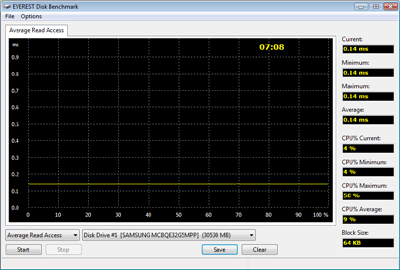
AIDA64 offers several different benchmarks for testing and optimizing your system or network. The Random Access test is one of very few if not only that will measure hard drives random access times in hundredths of milliseconds as oppose to tens of milliseconds.
Drives with only one or two tests displayed in the write test mean that they have failed the test and their Maximum and possibly their Average Scores were very high after the cache fills. This usually happens only with controllers manufactured by JMicron and Toshiba.

Here we see the increased latency from the new 20nm flash. Intel uses different firmware on the 335 than it does with the 520, but we don't have any specific details on what may of changed to increase the latency. AIDA64 has produced repeatable results in the past when testing the same drive over and over again so were pinning the .02ms increase on the flash.

The write latency also increased .02ms on average with 64KB blocks.
Benchmarks - CrystalDiskMark
CrystalDiskMark
Version and / or Patch Used: 3.0 Technical Preview
Developer Homepage: http://crystalmark.info
Product Homepage: http://crystalmark.info/software/CrystalDiskMark/index-e.html
Download here: http://crystaldew.info/category/software/crystaldiskmark
CrystalDiskMark is a disk benchmark software that allows us to benchmark 4K and 4K queue depths with accuracy.
Key Features:-
* Sequential reads/writes
* Random 4KB/512KB reads/writes
* Text copy
* Change dialog design
* internationalization (i18n)
Note: Crystal Disk Mark 3.0 Technical Preview was used for these tests since it offers the ability to measure native command queuing at 4 and 32.

The increased latency has an effect on 4K read performance. The Intel 335 delivers 29.79MB/s at QD1 and the Intel 520 delivers 32.36MB/s. When scaling to QD4 the 335 has 67.78MB/s, but the 520 scales all the way to nearly 100MB/s.
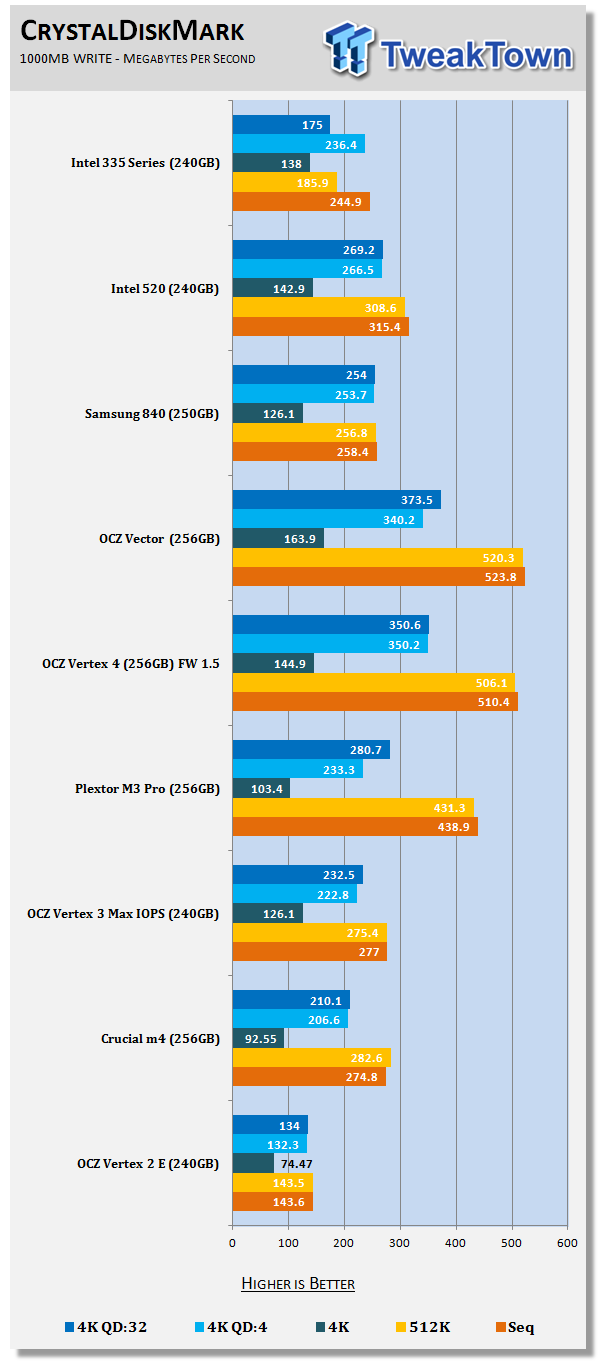
The Intel 520 was one of the few SF-2281 240GB SSDs to not scale from the QD4 to the QD32 test. The Intel 335 is the only SF-2281 drive to lose performance between QD4 to QD32. We think this is an artificial reduction to keep users from taking the 335 into enterprise environments. We have one other SSD with SF-2281 and 20nm flash and they don't show the same QD32 fall back.
In this test we also see sequential performance with incompressible data. This is an area where the 520 pulls far ahead from the 335. Up until this point there really wasn't a reason to choose the 520 over the 335 aside from the warranty and rated flash P/E cycle, but now we see there is a real difference between these two products.
Benchmarks - PCMark Vantage Hard Disk Tests
PCMark Vantage - Hard Disk Tests
Version and / or Patch Used: 1.0.0
Developer Homepage: http://www.futuremark.com
Product Homepage: http://www.futuremark.com/benchmarks/pcmark-vantage/

PCMark Vantage is the first objective hardware performance benchmark for PCs running 32 and 64 bit versions of Microsoft Windows Vista. PCMark Vantage is perfectly suited for benchmarking any type of Microsoft Windows Vista PC from multimedia home entertainment systems and laptops to dedicated workstations and high-end gaming rigs. Regardless of whether the benchmarker is an artist or an IT Professional, PCMark Vantage shows the user where their system soars or falls flat, and how to get the most performance possible out of their hardware. PCMark Vantage is easy enough for even the most casual enthusiast to use yet supports in-depth, professional industry grade testing.
FutureMark has developed a good set of hard disk tests for their PCMark Vantage Suite. Windows users can count on Vantage to show them how a drive will perform in normal day to day usage scenarios. For most users these are the tests that matter since many of the old hat ways to measure performance have become ineffective to measure true Windows performance.

HDD1 - Windows Defender
HDD2 - Gaming
HDD3 - Windows Photo Gallery
HDD4 - Vista Startup
HDD5 - Windows Movie Maker
HDD6 - Windows Media Center
HDD7 - Windows Media Player
HDD8 - Application Loading
In Vantage the 520 is faster than the 335 across the board (except Media Player), but only by a small margin.
Both drives are very close to OCZ's new Vector 256GB SSD in these daily use tests, one of the fastest drives on the market today.
Benchmarks - PCMark Vantage - Drives with Data Testing
For a complete breakdown on the Drives with Data Testing please read this article. You will be able to perform this test at home with the files provided in the article - full instructions are included.
- Brief Methodology
SSDs perform differently when used for a period of time and when data is already present on the drive. The purpose of the Drives with Data testing is to show how a drive performs in these 'dirty' states. SSDs also need time to recover, either with TRIM or onboard garbage collection methods.
Drives with Data Testing - 25%, 50%, 75% Full States and Dirty / Empty Test
Files needed for 60 (64GB), 120 (128GB), 240 (256GB)
60GB Fill - 15GB, 30GB, 45GB
120GB Fill - 30GB, 60GB, 90GB
240GB Fill - 60GB, 120GB, 160GB
Empty but Dirty - a test run just after the fill tests and shows if a drive needs time to recover or if performance is instantly restored.

On the previous page we saw Vantage performance on an empty drive. SandForce controllers due to their data compression have always done well here. Intel SandForce drives almost always do better than the run of the mill Team SandForce drives.
Using the 50% mark as a measuring stick (the middle bar in each group), the 335 does very well and is only outperformed by the 520 Series 240GB.
Benchmarks - Anvil Storage Utilities
Anvil Storage Utilities
Version and / or Patch Used: RC5
So what is Anvil Storage Utilities? First of all, it's a storage benchmark for SSDs and HDDs where you can check and monitor your performance. The Standard Storage Benchmark performs a series of tests, you can run a full test or just the read or the write test or you can run a single test, i.e. 4K DQ16.
Anvil Storage Utilities is not officially available yet but we've been playing with the beta for several months now. The author, Anvil on several international forums has been updating the software steadily and is adding new features every couple of months.
The software is used several different ways and to show different aspects for each drive. We've chosen to use this software to show the performance of a drive with two different data sets. The first is with compressible data and the second data set is incompressible data. Several users have requested this data in our SSD reviews.
Fill Compressible Data

Incompressible Data

The Intel 335 Series uses the LSI SandForce SF-2281 controller so the architecture works with incompressible data a little different. The incompressible performance is slower than the compressible performance. Here we see the performance drop off.
QD32 Random Read
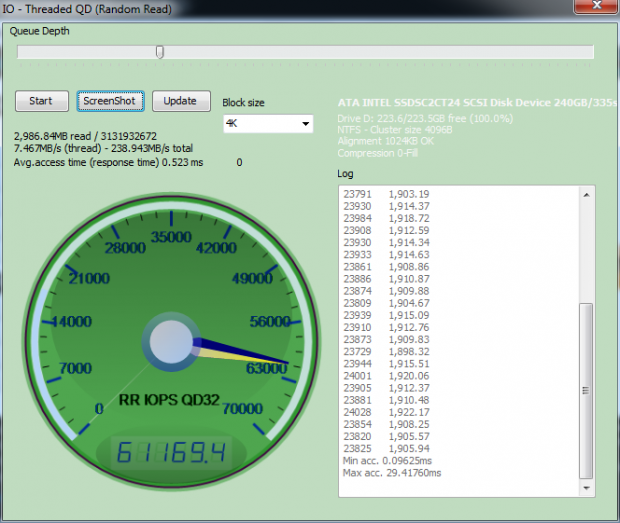
Our random read performance with 4K data and a queue depth of 32 was 61K IOPS.
QD32 Random Write

Our random write IOPS test under the same perimeters recorded 91K IOPS. Both are much better than Intel's claimed spec. We think Intel measured with mixed compressible and incompressible data.
Benchmarks - BootRacer
BootRacer - System Boot Time
Version and / or Patch Used: 4.0
Developer Homepage: Greatis
Product Homepage: BootRacer
Download here: http://www.greatis.com/bootracer/download.htm
Note: In this test we use the Lenovo W530 Mobile Workstation loaded with an operating system and several program files. The data on the drive at the time of the test is 45GB. The second test, 50GB Free, was run with the drives filled with block data until only 50GB of free capacity remained.
Time to Desktop

The Time to Desktop performance is very good on the Intel 335 240GB. The drive registered one of the best results to date.
Benchmarks - DiskBench
DiskBench - Directory Copy
Version and / or Patch Used: 2.6.2.0
Developer Homepage: Nodesoft
Product Homepage: DiskBench
Download here: http://www.nodesoft.com/diskbench/download
Note: In this test we use the Lenovo W530 Mobile Workstation and a SuperSSpeed S301 SLC 128GB SSD to move a 15GB block of data to and from the target drive. This is part of our real world test regiment. Roughly 45GB of data resides on the target drive before the '15GB Block' is transfer. The 15GB Block is the same data we built for the Data on Disk Testing and is a mix of compressible and incompressible data.
Directory Copy
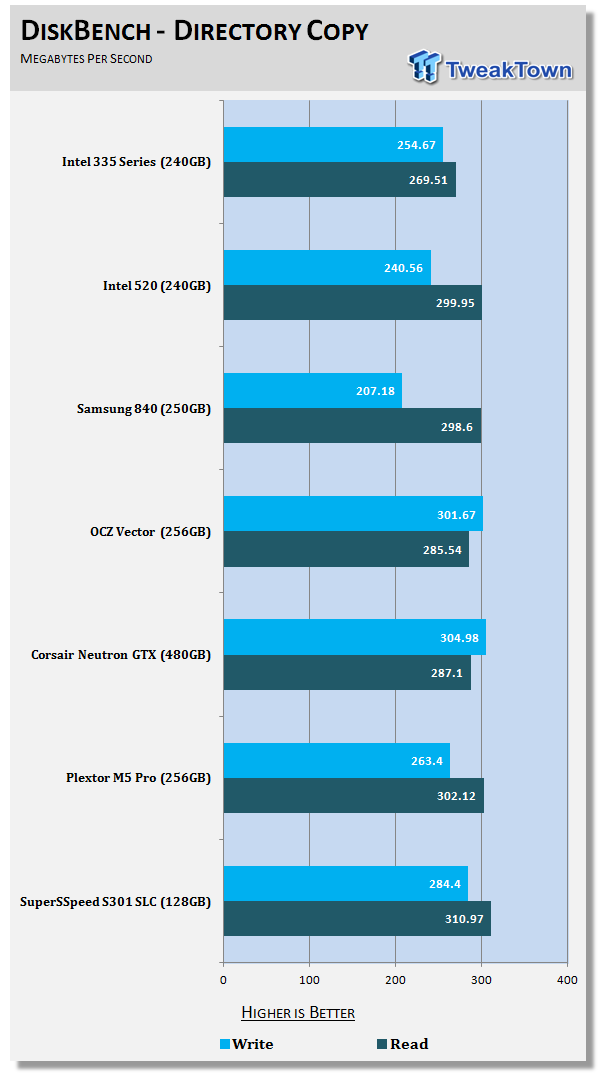
Oddly enough, in our real-world directory copy test that uses a mix of compressible and incompressible data in a directory, the 335 beat the 520 when writing data. The 520 still had a solid 30MB/s lead when reading data, though.
Benchmarks - Power Testing
Bapco MobileMark 2012 1.5
Version and / or Patch Used: 2012 1.5
Developer Homepage: http://www.bapco.com
Test Homepage: http://www.bapco.com
MobileMark 2012 1.5 is an application-based benchmark that reflects usage patterns of business users in the areas of office productivity, media creation and media consumption. Unlike benchmarks that only measure battery life, MobileMark 2012 measures battery life and performance simultaneously, showing how well a system design addresses the inherent tradeoffs between performance and power management.

The power charts are starting to get a little difficult to single out an individual drive so we isolated a couple of models below.

Intel's claims of better battery life with the 335 when compared to the 520 with 25nm NAND are accurate. Intel still isn't up to Samsung's 840 battery power time, but the 335 is very close.
PCMark Vantage HDD Test - Power Draw

The same is true for our Power Over Time test with Vantage.

Here we see the same three drives singled out and can start to understand where the power savings come from. The power use when writing data is about the same, but the 335 does peak a little higher when working with random writes.
The Samsung 840 250GB has the lowest idle and sequential read power draw, but as you can see here, the sequential writes and random writes take more power. The high peaks are random writes and the Samsung 840 spikes much higher than either of the two Intel drives.
When looking at the two Intel drives, the 335 has a much lower idle power draw and uses less power when reading data. Both the 335 and 520 use about the same power when writing data and the 335 bursts a little higher when writing random data.
Final Thoughts

Admittedly, I spent more time in the review looking at how the new 335 Series compared to the 520 Series that I largely ignored the Samsung 840 250GB. The 335 is good enough to compare to Intel's flagship consumer SSD and for the most part walks away from Samsung's new mainstream SSD in this capacity size. In Samsung's marketing material, they gave us a little blurb about how some SSDs lose performance when working with incompressible data. What they failed to mention is the 250GB 840 doesn't have high compressible or incompressible performance when doing anything other than reading large amounts of sequential data.
We really like Intel's approach to the mainstream SSD market - use higher program erase cycle NAND for the flagship and deliver a high speed solution with synchronous flash to mainstream users. This is a much better option than putting out a drive with asynchronous flash and I think it works out well. The Intel 520 Series gets hammered sometimes for its price, but it's one of the most reliable SSDs on the market today and delivers the best SandForce / MLC performance. The 335 follows right along with very close to flagship performance, but uses 'regular' 3K P/E flash and is knocked down a bit with some firmware tricks. For most users, the two are indistinguishable and that makes the 335 a product that appeals to not only mainstream folks, but also enthusiasts as well.
With a price well below the $1 per GB mark and Intel's proven reliability, the 335 is a solid offering. Once you throw in the performance, the picture becomes really clear. The question isn't if this is a product you should buy, but is there another drive on the market today you should even consider buying instead.
Let's go through the list of possibilities in the 240GB/256GB capacity size. The Neutron GTX, Vector and 840 Pro all cost more to significantly more for better performance, but that performance is only realized during intense multitasking. Both the Neutron non-GTX and Samsung 840 cost about the same as the 335, but we can dismiss the 840 for lack of write performance and the Neutron takes a big hit when 50% full. The same thing comes up with the Plextor M5 and M5 Pro, low 50% full performance. The Plextor M3 Pro 256GB though didn't have the same low 50% issue, but the drive went MIA when the new M5 Series came out. Finally, that leaves us with Team SandForce, the large collection of drives that are all nearly identical and sold by companies that don't have the same level of control with firmware like Intel does. Issues with BSOD and TRIM really turned a lot of people off of SandForce and gaining their trust again is an uphill battle.
To put it bluntly, others SandForce and Intel SandForce aren't the same. We like others SandForce for their performance and price, but we don't like playing firmware shuffle. Enthusiasts don't really mind, you can give us a firmware, tell us the drive will crash if left on for three days straight, but gives a 10% performance increase and we'll run it. The 335 isn't designed for enthusiasts, it's a mainstream build with mainstream reliability. It's not going to need three firmware updates just to get the features advertised on the box to work right, it just works right from the start...except for one little issue that doesn't affect performance or reliability and Intel has already addressed the issue with the wear level counter.
With all of that worked out, is there another drive that offers what the 335 240GB does? I can think of one, but it costs $50 more - the Intel 520 Series. I don't think the 520 Series offers $50 worth of addition performance to recommend it over the 335 Series for general consumers unless you're using the drive heavily for multitasking or very heavy incompressible data use. For most of us there really isn't going to be much of a difference, and that makes the 335 Series the best price vs. performance vs. reliability SSDs on the market today.
I'm not crying tears of joy though because Intel left two features off the table that should have been included. The first is a 7mm z-height for ultrabook users. Intel is pushing ultrabooks, but they don't make 335 in an ultrabook form factor. At this point no company should release a 9.5mm z-height drive. The second is one we're still waiting to hear more about and that is SandForce's new B02 revision of the 2281. B02 is the lower power yet same performance controller. Intel made great strides in the power consumption category with 20nm flash, but they came up short to Samsung's 840. The 335 Series gave us the third best battery life test result we've recorded, but when we see a new Intel SSD, we don't expect a second or third place result in any category. When Intel says lower power consumption, we pretty much take that as a statement saying they are going to do it better than anyone else. That didn't happen this time, but the other features make up for our high expectations not being totally fulfilled.


 United
States: Find other tech and computer products like this
over at
United
States: Find other tech and computer products like this
over at  United
Kingdom: Find other tech and computer products like this
over at
United
Kingdom: Find other tech and computer products like this
over at  Australia:
Find other tech and computer products like this over at
Australia:
Find other tech and computer products like this over at  Canada:
Find other tech and computer products like this over at
Canada:
Find other tech and computer products like this over at  Deutschland:
Finde andere Technik- und Computerprodukte wie dieses auf
Deutschland:
Finde andere Technik- und Computerprodukte wie dieses auf